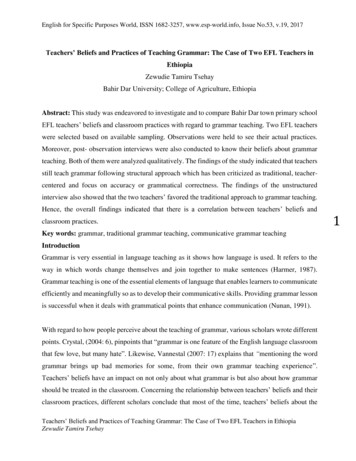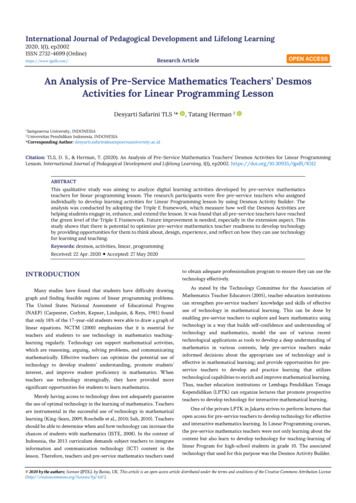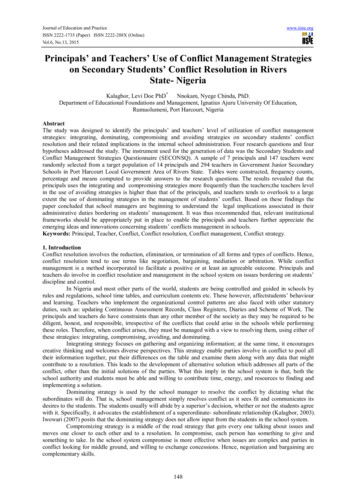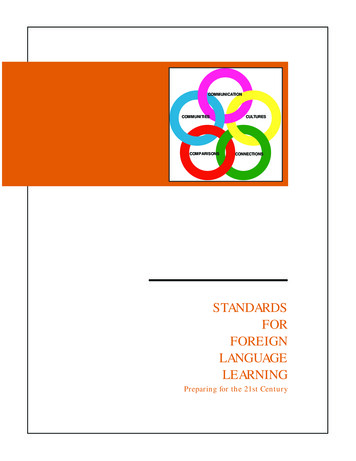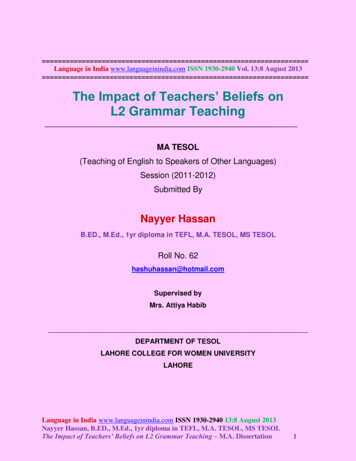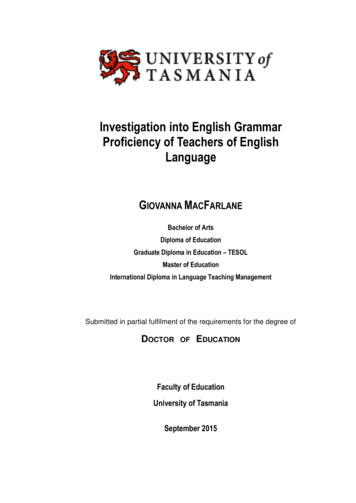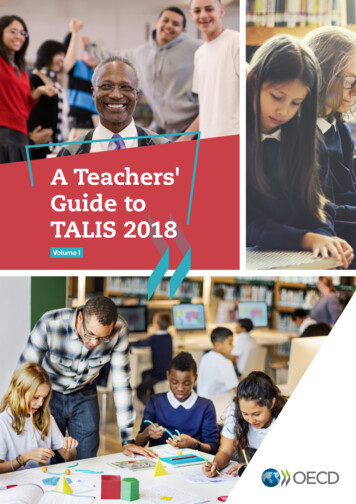
Transcription
A Teachers'Guide toTALIS 2018Volume I
Foreword“The skills that students need to contribute effectively tosociety are in constant change. Yet, our education systemsare not keeping up with the fast pace of the world aroundus. Most schools look much the same today as they dida generation ago, and teachers themselves are often notdeveloping the practices and skills necessary to meet thediverse needs of today’s learners Recognising that education is the great equaliser in society,the challenge for all of us is to equip all teachers with theskills and tools they need to provide effective learningopportunities for their students.”Angel GurríaOECD Secretary-GeneralNote by TurkeyThe information in this document with reference to “Cyprus” relates to the southern part of the Island. There is no singleauthority representing both Turkish and Greek Cypriot people on the Island. Turkey recognises the Turkish Republic ofNorthern Cyprus (TRNC). Until a lasting and equitable solution is found within the context of the United Nations, Turkeyshall preserve its position concerning the “Cyprus issue”.Note by all the European Union Member States of the OECD and the European UnionThe Republic of Cyprus is recognised by all members of the United Nations with the exception of Turkey. Theinformation in this document relates to the area under the effective control of the Government of the Republic ofCyprus.The statistical data for Israel are supplied by and under the responsibility of the relevant Israeli authorities. The useof such data by the OECD is without prejudice to the status of the Golan Heights, East Jerusalem and Israelisettlements in the West Bank under the terms of international law.This work is published under the responsibility of the Secretary-General of the OECD. The opinions expressed andthe arguments employed herein do not necessarily reflect the official views of OECD member countries.This document and any map included herein are without prejudice to the status of or sovereignty over any territory, tothe delimitation of international frontiers and boundaries and to the name of any territory, city or area.You can copy, download or print OECD content for your own use, and you can include excerpts from OECDpublications, databases and multimedia products in your own documents, presentations, blogs, websites andteaching materials, provided that suitable acknowledgment of OECD as source and copyright owner is given. Allrequests for commercial use and translation rights should be submitted to rights@oecd.org. OECD 2019Photo credits: Shutterstock/AVAVA - Shutterstock/Monkey Business Images - Shutterstock/Rawpixel.com- Shutterstock/Rawpixel.com - Shutterstock/Matej Kastelic - Shutterstock/Gorodenkoff - Shutterstock/Jacob Lund - Hill Street Studios /Gettyimages
What’s going onin class?Lower-secondary teachers in OECD countriesspend the equivalent of 47 minutes per hourof class time actually teaching. The OECDTeaching and Learning International Survey(TALIS) finds that teachers with more than fiveyears of teaching experience spend more timeon actual teaching and learning (the equivalentof 3 additional minutes per 60-minute lesson)than novice teachers (those with five years ofteaching experience or less).While more than 80% report that they cansuccessfully manage their classes, more than30% acknowledge that they have difficultymotivating students to learn, especially thosestudents who show little interest in schoolwork. This aspect of teachers’ work is morechallenging for novice teachers: 78% ofthem – compared with 87% of experiencedteachers – report that they feel they can controldisruptive behaviour in their classroom.Across OECD countries, lower secondaryteachers spend an average of 8 minutes perhour of class time keeping order in the class.IN PRACTICE:Classroom management trainingSchool leaders can make available – and encourage their teaching staff to attend– recurring training opportunities in classroom management and in motivatingstudents to learn. School leaders could also identify more experienced teachersto work with novice teachers who need assistance with classroom management.Many prefectures in Japan have extended induction programmes over 3-5years. These emphasise strengthening classroom management and the generalpedagogical skills of new teachers. With the help of experienced “guidanceteachers”, new teachers receive continuous, on-site mentorship and supportsuited to the local context and the needs of individual schools. Such long-termprogrammes prioritise the basic and general competencies required to work withstudents first, followed by more technical learning. They can also allow teachers tohave lighter workloads as they strengthen and develop a range of competencies. OECD 2019 A Teachers’ Guide to TALIS 20183
Figure 1. Teachers' self-efficacyPercentage of lower secondary teachers who feel they can do the following "quite a bit"or "a lot" (OECD average 31)Make my expectations about studentbehaviour clearCLASSROOMMANAGEMENTGet students to follow classroom rulesControl disruptive behaviourin the classroomCalm a student who is disruptive or noisyProvide an alternative explanation,for example, when students are confusedCraft good questions for studentsINSTRUCTIONVary instructional strategiesin my classroomUse a variety of assessment strategiesGet students to believe they can do wellin school workSTUDENTENGAGEMENTHelp students value learningHelp students think criticallyMotivate students who show low interestin school workENHANCEDACTIVITIESSupport student learning through the useof digital technology0102030405060708090100 %Values are ranked in descending order of teachers' self-efficacy.Source: OECD, TALIS 2018 Database, Table I.2.20.During class time spent on teaching, the vastmajority of teachers – 70% to 90% of them– report that they frequently use “clarity-ofinstruction” practices, which include explainingto students what they are expected to learn;explaining how new and old topics are related;and referring to a problem from daily life todemonstrate why the knowledge in questionis useful.practices, teachers encourage students tofind creative and alternative ways to solveproblems, and ask them to communicatetheir thinking processes and results with theirpeers and teachers. The OECD Programmefor International Student Assessment(PISA), among other studies, has foundcognitive-activation teaching strategies to bepositively related to student performance andachievement.A much smaller proportion of teachers – only35% to 60% – uses “cognitive-activation”strategies with their students. With these4A Teachers’ Guide to TALIS 2018 OECD 2019
IN PRACTICE:Using effective teaching strategiesSchool leaders can encourage their teaching staff to use cognitive-activationstrategies in class, and can provide on-site training in the use and importanceof these strategies. They could also allocate a certain number of hours in theirteachers’ work schedule to discuss and share ideas about how to implementeffective practices, such as cognitive activation strategies, into their classrooms.TeachingWorks, an organisation based at the University of Michigan (UnitedStates), focuses on helping teachers use effective teaching practices so that allstudents have access to them. It emphasises what are known as high-leveragepractices – practices that represent the “best bets” among those skills that arecentral to foster learning and promote equity.The Portuguese government launched the Project for Autonomy and CurriculumFlexibility to enable schools to promote teaching practices that facilitatebetter learning and holistic skills development among students. As part of theprogramme, schools identify student learning objectives aligned with the NationalSkills Strategy and student competency framework, which include 21st-centuryskills and cross-curricular competencies, and adapt their curriculum accordingly.Teachers and principals at the school level collaborate professionally to introducenew pedagogical approaches, interdisciplinary and cross-classroom activitiesaligned to these student learning objectives. The project thus promotes innovationin teaching methods at the school level, driven by educators themselves.Nearly two in ten teachers (19%) across OECDcountries are novices compared with fewer thanone in ten in Viet Nam (9%), Lithuania (7%) andPortugal (3%). Novice teachers work one hourless per week than teachers with more thanfive years of experience, on average acrossOECD countries; but this is because noviceteachers tend to work part-time more oftenthan experienced teachers do.Novice teachers represent 22% of theteacher population on average across OECDcountries, but 22% of teachers in schools withhigh concentrations of students from socioeconomically disadvantaged homes, and 23%of teachers in schools with high concentrations OECD 2019 A Teachers’ Guide to TALIS 2018of immigrant students are novice teachers.Perhaps because they tend to work in morechallenging environments, novice teachers areless likely than experienced teachers to feelconfident in their teaching skills. For example,on average across OECD countries, 75% ofnovice teachers feel they can use a varietyof assessment strategies “quite a bit” or “alot”, compared to 81% of more experiencedteachers. A slightly smaller percentage ofnovice teachers than experienced teachers(a difference of 5 percentage points) feelsconfident helping students value learning andmotivating students who show low interest inschool work.5
Figure 2. Teaching practicesPercentage of lower secondary teachers who "frequently" or "always" use the followingpractices in their class1 (OECD average 31)Tell students to follow classroom rulesCLASSROOMMANAGEMENTTell students to listen to what I sayCalm students who are disruptiveWhen the lesson begins, tell studentsto quieten down quicklyExplain what I expect students to learnExplain how new and old topicsare relatedSet goals at the beginning of instructionCLARITY OFINSTRUCTIONRefer to a problem from everyday life or workto demonstrate why new knowledge is usefulPresent a summary of recently learnedcontentLet students practise similar tasks untilI know that every student has understoodthe subject matterGive tasks that require studentsto think criticallyCOGNITIVEACTIVATIONHave students work in small groups to comeup with a joint solution to a problem or taskAsk students to decide on their ownprocedures for solving complex tasksPresent tasks for which there isno obvious solutionENHANCEDACTIVITIESLet students use ICT for projectsor class workGive students projects that require at leastone week to complete0102030405060708090100 %These data are reported by teachers and refer to a randomly chosen class they currently teach from their weekly timetable.1Note: ICT refers to information and communication technologyValues are grouped by teaching strategy and ranked in descending order of the use of teaching practices within therespective teaching strategy.Source: OECD, TALIS 2018 Database, Table I.2.1.6A Teachers’ Guide to TALIS 2018 OECD 2019
IN PRACTICE:Supporting novice teachersThe way novice teachers are allocated across schools needs to be reviewed, withthe aim of assigning them to less challenging working environments in their firstplacements. If assigning novice teachers to a challenging school is unavoidable,school leaders can ease the transition of recent graduates into the professionby allocating them to less challenging classes, considering pairing them withmore experienced teachers in joint teaching arrangements, or releasing noviceteachers from some teaching duties to ensure that they can spend more timepreparing their lessons.The government of New South Wales, Australia, provides support to schoolsfor beginning teachers’ induction and professional development, guided by theAustralian Professional Standards for Teachers. Under the Beginning TeachersSupport Funding programme, the principals of schools receiving this specialfunding are responsible for ensuring, among other things, that beginning teachershave fewer responsibilities or lighter teaching loads so they can better develop theirskills; that beginning teachers are provided with ongoing feedback and support;and that mentoring structures and collaborative practices support beginningteachers within the school or across a cluster of schools.What do teachers want?If given the opportunity to decide, how wouldteachers choose to allocate additional resourcesfor their school? For the first time, TALIS 2018asks teachers to rate the importance of anumber of priorities if the education budgetwere increased by 5%. On average acrossOECD countries, according to teachers, thenumber one spending priority is “reducingclass size by recruiting more staff” (rated ofhigh importance by 65% of teachers). Some55% of teachers also rate “reducing teachers’administration load by recruiting more supportstaff” as of high importance. These two findingsindicate that teachers want to be able to focusmore on the core of their work: student learning.Some 64% of teachers cite “improving teachers’salaries” as of high importance. But TALIS findsthat the lower the teachers’ statutory salariesin a country (in purchasing power parity terms),or the lower teachers’ salaries are compared tothose of similarly educated workers, the more OECD 2019 A Teachers’ Guide to TALIS 2018teachers consider raising their salaries to bea priority. In a number of countries, teachersworking in cities, where housing prices and thecost of living are typically higher than in ruralareas, are more likely than their peers workingin rural areas to consider salary increases as“highly important”.These three actions, along with “offeringhigh-quality professional development forteachers” (also cited by 55% of teachers) arerated of high importance by more than 50%of teachers. By contrast, “improving schoolbuildings and facilities”, “supporting studentswith special needs”, “investing in ICTs”,“supporting students from disadvantaged orimmigrant backgrounds” and “investing ininstructional materials” are considered to beof high importance by less than a majority ofteachers – although 30% to 50% of teachersconsider them highly important.7
Figure 3. Spending priorities for lower secondary educationPercentage of lower secondary teachers who reported the following spending priorities to beof high importance1 (OECD average 31)Reducing class sizes by recruiting more staffImproving teacher salariesOffering high-quality professionaldevelopment for teachersReducing teachers’ administration loadby recruiting more support staffImproving school buildings and facilitiesSupporting students with special needsInvesting in ICTSupporting students from disadvantagedor immigrant backgroundsInvesting in instructional materials010203040506070%Respondents were not asked to prioritise; they had the possibility to attribute "high importance" to all spending priorities.1Values are ranked in descending order of the percentage of lower secondary teachers who reported the above spending prioritiesto be of high importance.Note: ICT refers to information and communication technologySource: OECD, TALIS 2018 Database, Table I.3.66.8A Teachers’ Guide to TALIS 2018 OECD 2019
What’s going onin school?Teachers need to be prepared to handlediversity in all of its forms in their classes. Forexample, on average across OECD countries\\nearly 3 in 10 lower secondary teachers workin a school where at least 10% of studentshave special needs\\2 in 10 work in a school where at least30% of students are socio-economicallydisadvantaged.With migration on the rise in many parts of theworld, the children of immigrants are enrolled inthe school systems of their host countries, oftenrequiring specific support from their schoolsand teachers. TALIS finds that in schools inOECD countries:\\just under 2 in 10 lower secondary teacherswork in a school where at least 10% ofstudents have an immigrant background\\around 3 in 10 work in a school where at leasta phenomenon related to migration flows,it can also reflect the presence of linguisticor Indigenous minorities in a country. TALISfinds that just over 2 in 10 lower secondaryteachers work in a school where at least 10%of students do not speak the language ofinstruction at home.Around 8 in 10 teachers who work inmulticultural schools do so in a school thathas integrated global issues throughout thecurriculum, and teaches students how to dealwith ethnic and cultural discrimination. Policiesand practices promoting diverse cultures areless common: just over 6 in 10 teachers workingin multicultural schools do so in a school thatsupports activities or organisations encouragingstudents’ expression of diverse ethnic andcultural identities. Worryingly, around 3 in 10teachers in OECD countries report that theycannot cope with the challenges of teachinga multicultural class (and 15% of teachers inOECD countries report that they need moretraining in this area).1% of students are refugees.Teachers also need to be prepared to work withstudents who may not be fluent in the languageof instruction. While linguistic diversity is OECD 2019 A Teachers’ Guide to TALIS 20189
IN PRACTICE:Supporting diversitySchool leaders can design policies and apply practices that ensure that all students,regardless of their socio-economic and cultural origin, can learn. Teachers cantake advantage of pre- and in-service training that addresses these issues.In Kazakhstan, teachers visit disadvantaged households, as part of the Careprogramme, to identify students who are out of school or have been absent formore than ten days without a valid reason. Teachers interact with these studentsand their families to identify the barriers preventing them from coming to schoolregularly and provide assistance to help them return to school. The programmehas supported more than 1.1 million disadvantaged students since 2010.The Ministry of Education in Austria has implemented a programme calledMobile Intercultural Teams that offers support to schools with a large proportionof immigrant students. These teams, composed of expert counsellors andpsychologists, work with teachers, principals and administrators at these schools,offering advice on issues such as working with immigrant students, and fosteringan inclusive and supportive classroom climate.Figure 4. School compositionPercentage of lower secondary teachers teaching in schools with the following composition(OECD average 30)%35302520151050More than 10%of students withspecial needAlt least 1%of students arerefugeesMore than 10%of students havea first language differentfrom the language(s)of instructionMore than 30%of students comefrom soci-economicallydisadvantageed homesMore than10%of students areimmigrants or havea migrant backgroundValues are ranked in descending order of the percentage of lower secondary teachers teaching in schools with thefollowing composition.Source: OECD, TALIS 2018 Database, Table I.3.25.10A Teachers’ Guide to TALIS 2018 OECD 2019
Figure 5. School practices related to equityPercentage of lower secondary principals reporting that the following policies and practicesare implemented in their school (OECD average 30)%1009080706050403020100Teaching students tobe inclusive of differentsocio-economic backgroundsAdditional support forstudents from disadvantagedbackgroundsExplicit policies againstgender discriminationExplicit policies againstsoci-economic discriminationValues are ranked in descending order of the prevalence of equity-related school practices.Source: OECD, TALIS 2018 Database, Table I.3.34.Figure 6. School practices related to diversityPercentage of lower secondary teachers working in a school with diverse ethnic and culturalstudent backgrounds where the following diversity-related practices are implemented1(OECD average 30)%1009080706050403020100Adopting teaching andlearning practices that integrateglobal issues throughoutthe curriculumTeaching how to deal withethnic and culturaldiscriminationSupporting activities ororganisations encouraging students’expression of diverse ethnicand cultural identitiesOrganising multiculturaleventsData based on principals' views. Principals' responses were merged with teacher data, and weighted using teacherfinal weights.1Values are ranked in descending order of the prevalence of diversity-related school practices.Source: OECD, TALIS 2018 Database, Table I.3.35. OECD 2019 A Teachers’ Guide to TALIS 201811
Figure 7. Teachers' self-efficacy in teaching multicultural classesPercentage of lower secondary teachers who feel they can do the following "quite a bit"or "a lot" in teaching a culturally diverse class1 (OECD average 31)%1009080706050403020100Reduce ethnicstereotyping amongststudents1Ensure that studentswith and without a migrantbackground work togetherRaise awarness ofcultural differencesamongst studentsCope with thechallenges of a multiculturalclassroomAdapt my teachingto the cultural diversityof studentsThe sample is restricted to teachers reporting that they have already taught a class with students from different cultures.Values are ranked in descending order of the percentage of teachers reporting that they feel they can do the following"quite a bit" or "a lot" in teaching a culturally diverse class.Source: OECD, TALIS 2018 Database, Table I.3.38.Over in the principal’s office, leaders of lowersecondary schools spend the largest chunkof their time (30%) doing administrative tasksand attending meetings. Only 16% of theirworking time is spent on curriculum andteaching-related tasks, such as developinga school curriculum, teaching, observingtheir teachers’ classes, mentoring teachers,designing or organising professionaldevelopment activities for teachers, or being12involved in student evaluations. Yet it is throughinstructional leadership that school leaders canhave the strongest and most positive impacton the quality of teaching in their school.Indeed, the “shortage or inadequacy of timefor instructional leadership” is one of the threeresource issues most often cited by schoolprincipals as hindering the school’s capacityto provide quality instruction “quite a bit” or “alot” (32% of principals so reported).A Teachers’ Guide to TALIS 2018 OECD 2019
IN PRACTICE:Taking time for instructional leadershipSchool leaders can reorganise their time so they can spend fewer hours doingadministrative tasks and more hours engaged in instructional leadership activities.Where school principals have autonomy for recruitment decisions, they couldcreate intermediate management roles. But even if school leaders do not haveresponsibility for these decisions, they could still devolve some managementand administrative tasks to teachers who show exceptional leadership skillsand are interested in building leadership capacity. School leaders can also takeevery opportunity to develop their instructional leadership skills by participatingin professional development activities, collaborating and networking with otherprincipals, and observing, mentoring and providing feedback to teachers.Figure 8. Time spent by principals on curriculum and teachingAverage proportion of time lower secondary principals report spending on curriculumand teaching-related tasks and lgiumFlemish Comm. (Belgium)AustriaHungaryColombiaCzech RepublicSloveniaOECD average-30CroatiaEngland (UK)Slovak RepublicBrazilLithuaniaFranceBulgariaUnited StatesItalyMaltaSpainMexicoNew ZealandCABA (Argentina)SingaporeAlberta (Canada)ChileRomaniaIsraelSouth AfricaSaudi ArabiaUnited Arab EmiratesGeorgiaKazakhstanKoreaJapanViet NamShanghai (China)0Including developing curriculum, teaching, classroom observations, student evaluation, mentoring teachers, teacherprofessional development.1Countries and economies are ranked in descending order of the average proportion of time lower secondary principalsreport spending on curriculum and teaching-related tasks and meetings in 2018.Source: OECD, TALIS 2018 Database, Table I.2.31. OECD 2019 A Teachers’ Guide to TALIS 201813
TALIS asks school principals about thefrequency with which a number of incidentsrelated to school safety (including the useor possession of drugs or alcohol at school;physical injury caused by violence amongstudents; vandalism and theft; the postingof hurtful information about students onthe Internet; intimidation or verbal abuse ofteachers/staff; or unwanted electronic contactamong students) occurs in their school. Oneissue stands out: intimidation or bullying amongstudents occurs at least once per week in 14%of schools, on average across OECD countries.But TALIS results also show that somecountries have been successful in reducingthe incidence of bullying over the past fiveyears. Contrasting daily or weekly incidents ofbullying reported in 2013 with daily or weeklyincidents of either bullying or posting of hurtfulinformation on the Internet reported in 2018reveals that 10 participating countries andeconomies managed to reduce the frequencyof these incidents during this period; but in3 other countries, the incidence of bullying,including cyberbullying, increased.IN PRACTICE:Preventing bullyingTeachers and school staff have a crucial role to play in preventing bullying.School-level disciplinary policies can focus on monitoring and supervisingall students, encouraging communication and partnerships among teachers,engaging parents and reinforcing classroom management. Incorporating socialand emotional learning during regular classroom hours can improve students’inter- and intrapersonal skills, and create a healthy environment in school. Trainingprogrammes for teachers and school leaders should be updated with the mostrecent trends in bullying both within and outside the school environment.The government of Alberta, Canada, implements a strategic approach to helpschools and teachers combat bullying among students. Teachers have accessto a wealth of resources, provided by the state, to identify signs of physical,social and cyber bullying in school. Guidance is also provided on how to involveparents and care givers in plans to respond to bullying. Teachers are asked notonly to observe school incidents to track bullying behaviour, but also to developstrategies promoting positive behaviour and informing students of what they cando if they witness bullying among their peers.While student-to-student interactions canoccasionally be harmful, TALIS finds thatrelations between teachers and their studentsare extremely positive. On average across OECDcountries, 96% of teachers concur that teachersand students usually get along well with one14another – a larger proportion than reported soin 2008 in most countries with available data.In addition, in the vast majority of countries,teachers’ belief in the importance of studentwell-being has strengthened since 2008.A Teachers’ Guide to TALIS 2018 OECD 2019
Figure 9. Change in bullying from 2013 to 2018Percentage of lower secondary principals reporting that the following incidents occurredat least weekly in their school20181%452013240353025201510Shanghai (China)-6KoreaJapanGeorgiaCzech RepublicIcelandItalyChile -12Croatia -10-6SpainDenmark-8PortugalSingapore7Slovak RepublicLatvia -14Estonia -11RomaniaNetherlandsAlberta (Canada) -11NorwayMexicoBulgariaFranceSwedenBrazil15England (UK)FinlandFlemish Comm. (Belgium) 13New Zealand 190Israel 155Data for TALIS 2018 refer to "Intimidation or bullying among students (or other forms of verbal abuse)" and/or "A studentor parent/guardian reports postings of hurtful information on the Internet about students".1In TALIS 2013, principals were asked to report on the frequency with which "Intimidation or verbal abuse among students(or other forms of non-physical bullying)" occurred in this school.2Notes: Only countries and economies with available data for 2013 and 2018 are shown.Statistically significant changes between 2013 and 2018 (TALIS 2018-2013) are found next to the category and thecountry/economy name.Countries and economies are ranked in descending order of the percentage of lower secondary principals reporting thatintimidation or verbal abuse of teachers or staff occurred at least weekly in their school in 2018.Source: OECD, TALIS 2018 Database, Table I.3.45. OECD 2019 A Teachers’ Guide to TALIS 201815
How do teachersand school leadersprepare for their job?Almost 70% of lower secondary teachersin OECD countries report that teaching wastheir first choice as a career. Across all TALISparticipating countries and economies, thepercentage of teachers who so report rangesfrom 49% in South Africa to 93% in Viet Nam.Results also show that those teachers whosefirst career choice was teaching are also morelikely to be satisfied with their job; and in twoout of three countries and economies thatparticipate in TALIS, those teachers also tendto report higher self-efficacy.What about the profession attracted teachersin the first place? For the first time, TALIS 2018asks teachers how important certain factorswere in motivating them to become a teacher.Around 90% of teachers say that influencingthe development of children and young people,and contributing to society was of moderateor high importance to them. Some 75% reportthat a desire to help socio-economicallydisadvantaged students spurred them to enterthe profession. Least-often cited as motivationto enter the teaching profession are factors16related to working conditions, such as teachingschedule, salary and job security (around 60%to 70% of teachers report that these were ofmoderate to high importance to them).Most teachers hold at least one highereducation degree. TALIS finds that, on averageacross OECD countries and economies, 50%of teachers completed only a bachelor’s degreeor equivalent and 44% completed a master’s
Figure 1. Teachers' self-efficacy Percentage of lower secondary teachers who feel they can do the following "quite a bit" or "a lot" (OECD average 31) Values are ranked in descending order of teachers' self-efficacy. Source: OECD, TALIS 2018 Database, Table I.2.20. Durin

